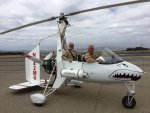mccarthyinv
Newbie
Greetings,
Does anyone have plans for a remote control Bensen Style Gyro?
I would like to make maybe ten of them, and then do all the things we read about but never saw, such as the high speed dive followed by a rapid pull, then nose down again for another high speed pass leading to the "Bunt Over" (Like the "Bunt Over" that got the guy killed in Japan, or the "Lets over-correct until the gyro gets sideways and knocks off the rudder" manuever, never saw it, but Ron describes it...a sort of "New Bee Killer").
We can film all of these fatal maneuvers that no body lives to talk about. Then in slow motion we can dissect it all, and learn what not to do...
We've all seen footage of a gyro crashing, but its usually a tiny blurred image to the point of not knowing what the hell is really going on.
Our videos would do a world of good to define what the "Flight Envelope" of a gyro-plane is. We could all view the videos and learn the do's and dont's of gyro flying.
Do you know the "Does and Don'ts"? All I ever heard was, "Don't unload the Rotor"..
With high quality video photage with an explanation, "An now I did this...or did that" by the remote pilot....and we could sit back and go "Ooooooh, got to remember never to try that!".
The majority of accidents I've seen is #1 Blade flap, (Ok, get rotor RPM indicator-solved), or #2. Lift off in a kind of "ground effect" where the craft is flying but out of the engines ideal RPM range so the gyro starts to bog, loose airspeed and settle back down to the ground, right about the time the runway ends...leading to a spetacular crash.......those are the easy fixes.
What gets me are the guys that have plenty of airspeed and seem to do a forward tumble. (And yet another throw-off to this research could be where would the ideal place to put a ballastic parachute is? It wont save you when you hit a power line, but most of the up high tumbles I've seen, the tail gets knocked off, the rotor slows and the craft pluges towards earth inverted, meaning a downward i.e. now skyward ballistic chute should work).
Any thoughts?
Does anyone have plans for a remote control Bensen Style Gyro?
I would like to make maybe ten of them, and then do all the things we read about but never saw, such as the high speed dive followed by a rapid pull, then nose down again for another high speed pass leading to the "Bunt Over" (Like the "Bunt Over" that got the guy killed in Japan, or the "Lets over-correct until the gyro gets sideways and knocks off the rudder" manuever, never saw it, but Ron describes it...a sort of "New Bee Killer").
We can film all of these fatal maneuvers that no body lives to talk about. Then in slow motion we can dissect it all, and learn what not to do...
We've all seen footage of a gyro crashing, but its usually a tiny blurred image to the point of not knowing what the hell is really going on.
Our videos would do a world of good to define what the "Flight Envelope" of a gyro-plane is. We could all view the videos and learn the do's and dont's of gyro flying.
Do you know the "Does and Don'ts"? All I ever heard was, "Don't unload the Rotor"..
With high quality video photage with an explanation, "An now I did this...or did that" by the remote pilot....and we could sit back and go "Ooooooh, got to remember never to try that!".
The majority of accidents I've seen is #1 Blade flap, (Ok, get rotor RPM indicator-solved), or #2. Lift off in a kind of "ground effect" where the craft is flying but out of the engines ideal RPM range so the gyro starts to bog, loose airspeed and settle back down to the ground, right about the time the runway ends...leading to a spetacular crash.......those are the easy fixes.
What gets me are the guys that have plenty of airspeed and seem to do a forward tumble. (And yet another throw-off to this research could be where would the ideal place to put a ballastic parachute is? It wont save you when you hit a power line, but most of the up high tumbles I've seen, the tail gets knocked off, the rotor slows and the craft pluges towards earth inverted, meaning a downward i.e. now skyward ballistic chute should work).
Any thoughts?


